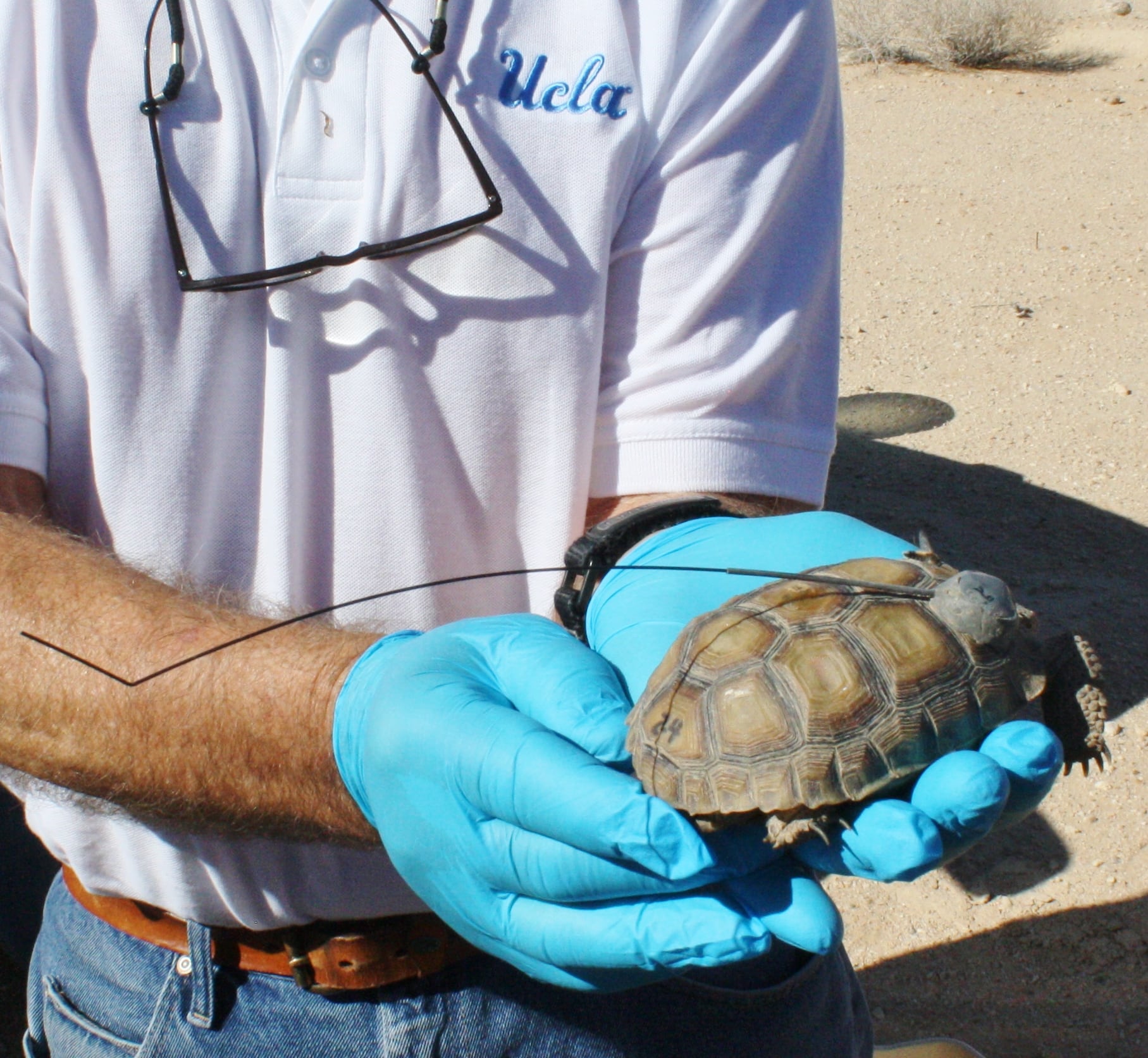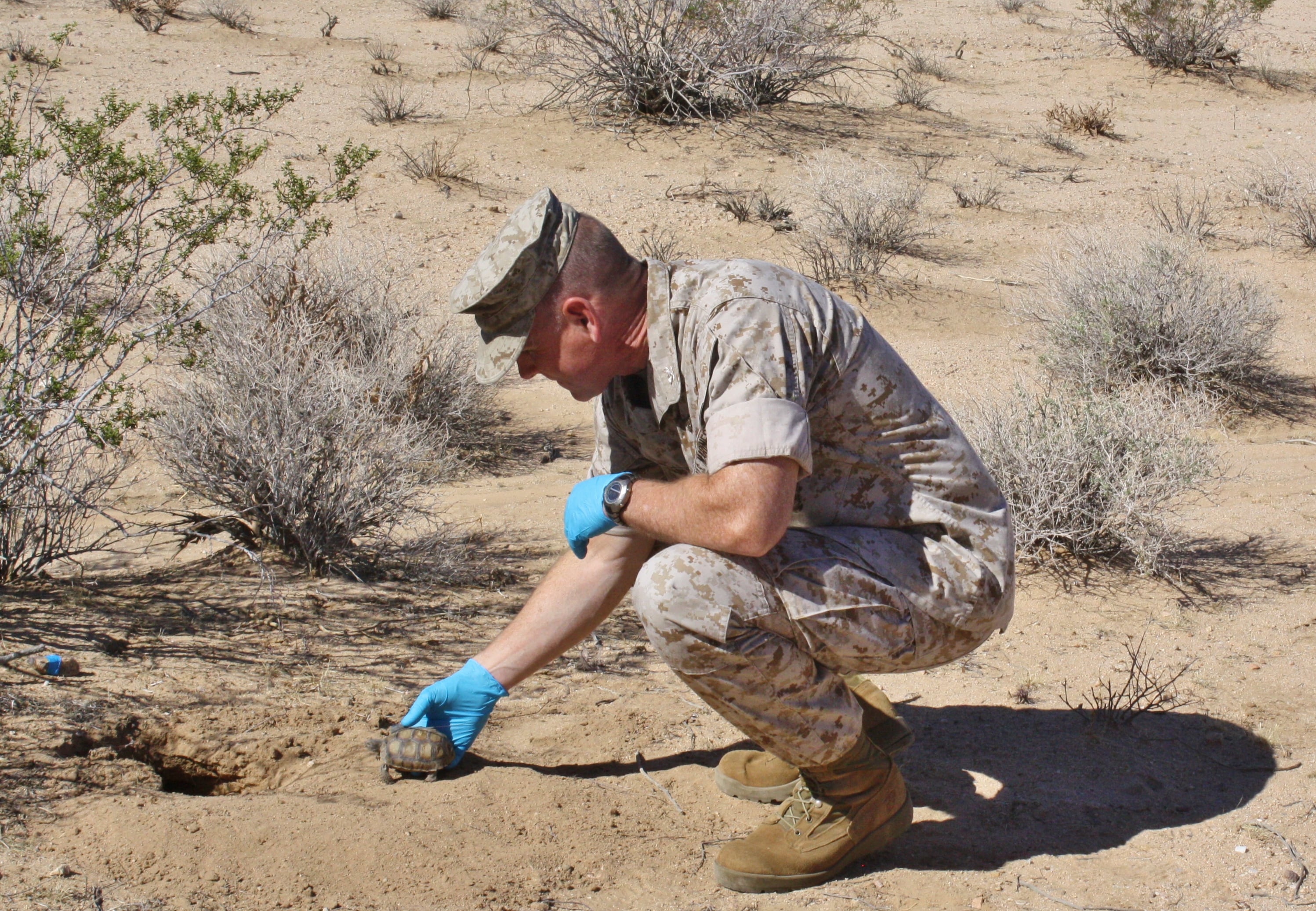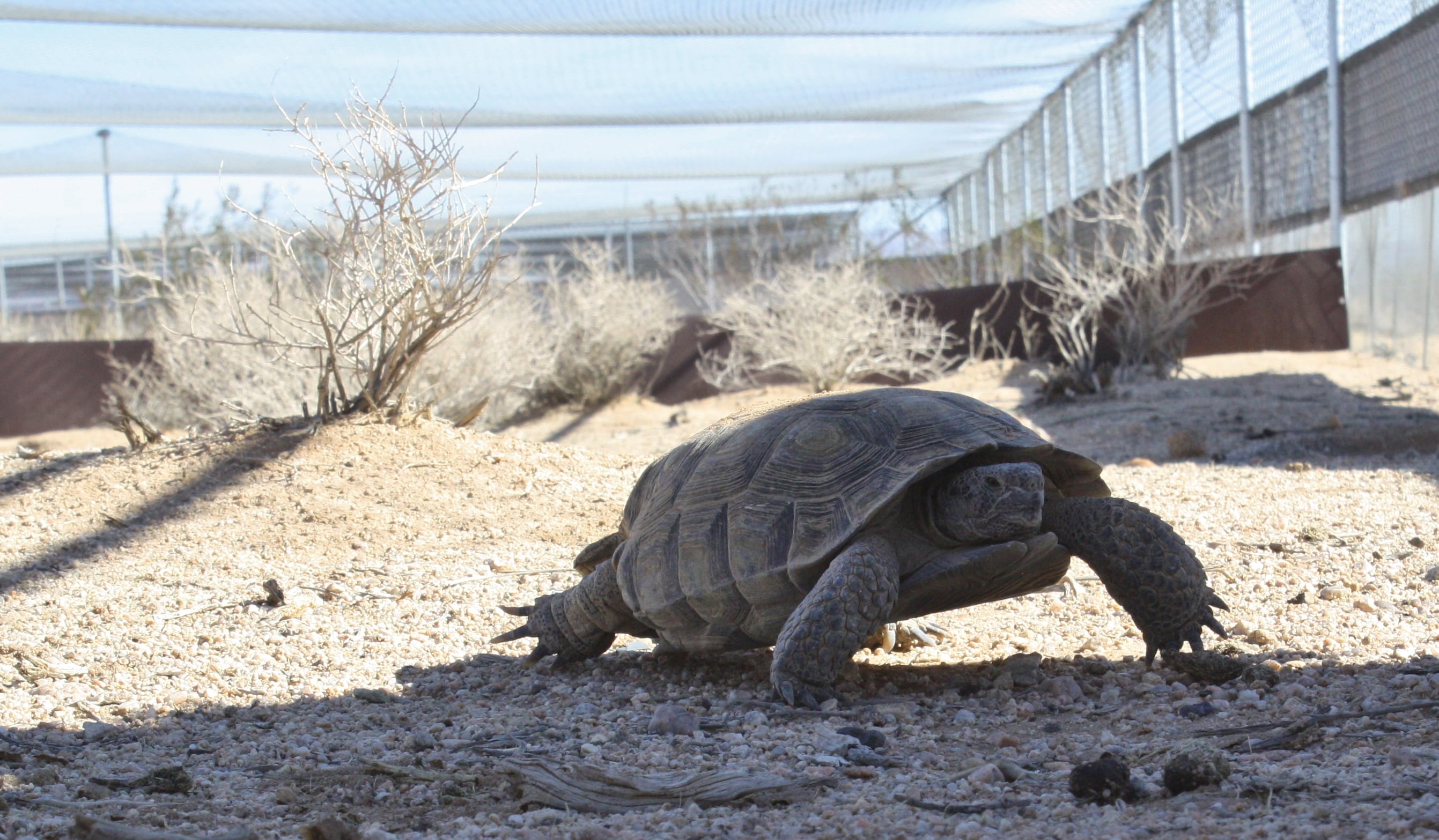MARINE CORPS AIR-GROUND COMBAT CENTER TWENTYNINE PALMS, Calif. — It took barely a minute or two for the young desert tortoise to scramble from the hand of Col. James Harp and into the cool shade of a burrowing hole four feet away.
Freedom at last. The desert tortoise, tagged with a transmitter and stamped with the bureaucratic name of "2-4," was the last of a cohort of 35 desert tortoises released into the wild by the Marine Corps.
The Sept. 30 release was nine years in the making.
"It's pretty significant," Harp told the crowd of two-dozen officials, local representatives and journalists gathered for the event.
The tortoise was among 475 threatened tortoises, Gopherus agassizii, housed in a fenced, secured "head start" facility the Marine Corps built in 2006 in a concerted effort to recover the threatened species that's seen adult mortality rates of 90 percent in recent decades. Starting in mid-September, biologists released the tortoises in mid-September leading up to the first public release here at in Sand Hill, a restricted training area at the 1,100-square-mile desert warfare training base.
Some may wonder why there's so much Why all the fuss over a tortoise, but the species The desert tortoise shares its desert home with members of the military. Survival is a battle for the desert tortoise. Military training, along with suburban sprawl, commercial activities, expanding solar and wind farms, cattle farms, and off-road recreation across the its Mojave Desert home have all helped decimated the population.
With expanded training ranges and activities in recent years, The military services have agreed to conservation programs like this one to mitigate impacts of expanded ranges and training, as well as to and study and help recover the species. That includes "head start" programs to safeguard young tortoises and translocation programs to move the reptiles from military training areas. The Army's "head start" facility at Fort Irwin, California, closed shop a few years ago after many of the hundreds of tortoises released and relocated didn't survive the first few months. A similar effort at Edwards Air Force Base, California, also saw disappointing results.

Reknowned desert tortoise expert and UCLA professor emeritus Kenneth A. Nagy holds "2-4," a 9-year-old desert tortoise raised at the Tortoise Research and Captive Rearing Site since its creation in 2006. The tortoise was released into the wild in the Sand Hill area of Marine Corps Air-Ground Combat Center Twentynine Palms, Calif.
Photo Credit: Gidget Fuentes for Marine Corps Times
The Marine Corps and the base's MCAGCC's Natural Resources and Environmental Affairs division collaborated with tortoise experts and federal agencies like the U.S. Fish and Wildlife Service on ways to give hatchlings and juveniles a fighting chance to grow big enough to ward off predators and survive on their own.
"We are trying to do things a little bit differently," Brian Henen, the base MCAGCC biologist Brian Henen said.
The six-acre Tortoise Research and Captive Rearing Site, or TRACRS ( pronounced like the word "tracers"), is the only one of its kind in the military and one of only two head-start efforts in the U.S. Hatchlings raised at TRACRS have as much as a 96 percent survival rate, double or triple what they would encounter in the wild, Henen said.
"That actually helps support our mission, the mission of training here at [Twentynine Palms] MCAGCC," he said. "Those go hand-in-hand, they mesh quite closely together with that objective of protecting tortoises but also protecting and sustaining the mission."
The desert tortoise isn't exactly Marine Corps material. It's slow and laid back. It's not predatory, preferring a vegetarian diet of leaves and flowers. When threatened, it slinks into its hardened shell for protection from predators like hawks, ravens and coyotes. If scared, it might urinate, emptying its bladder of its lifesaving supply of stored water.
Young tortoises, with their softer, thinner shells, are vulnerable to predators like hawks and coyotes looking for a snack and to Mother Nature's fickle side. Many of the Army and Air Force released tortoises released by the Army and Air Force were later found as pecked or crushed to death carcasses, biologists said. That led to the question: Would more survive if they were a little older?

Col. James Harp, Marine Corps Air-Ground Combat Center's chief of staff, releases a 9-year-old desert tortoise in the Sand Hill area. It was the last of 35 released from the Corps' Tortoise Research and Captive Rearing Site, a unique "head start" facility at the desert combat training center at Twentynine Palms, Calif., created to help recover the endangered species.
Photo Credit: Gidget Fuentes for Marine Corps Times
At 9 years old, tortoise "2-4" is like a teenager ready to tackle the big world on his own. (He might be a she. Biologists don't know yet if it's a male or female.)
The tortoise grew from a clutch of eggs brought to TRACRS in the program's first year in that maiden year of the program. About 50 juvenile tortoises have grown large enough — at least four to five inches, bigger than the size of a softball — to be eligible for release, Henen said.
Officials wanted to do the first release in 2014, but California's ongoing drought shriveled up vegetation, said Ken Nagy, a University of California at Los Angeles professor emeritus working with the Marine Corps since TRACRS' inception and who worked with Fort Irwin's program. Recent rains have helped.
"Our tortoises out here are hydrated. They love to drink rainwater," Nagy said, who also worked with Fort Irwin's program. Officials hope to do another release next year.

A pair of tortoises named Thelma, shown here, and Louise reside at Marine Corps Air-Ground Combat Center Twentynine Palms, Calif.
Photo Credit: Gidget Fuentes for Marine Corps Times
The 198-square-mile expansion here of MCAGCC had added a separate effort to save the desert tortoise. The Marine Corps will move as many as 1,200 tortoises to safer remote areas starting next year, officials said. Henen said 110 contracted biologists are helping survey and assess sites and find tortoises in a 200-square-kilometer area.
"We have to go out and find all the tortoises and move them from the high-impact areas," Lt. Col. Tim Pochop, the MCAGCC's environmental officer here, said.
Tortoises too small to wear transmitters are being put in new fenced-in pens at TRACRS, some of 660 to be monitored with transmitters, Henen said.




